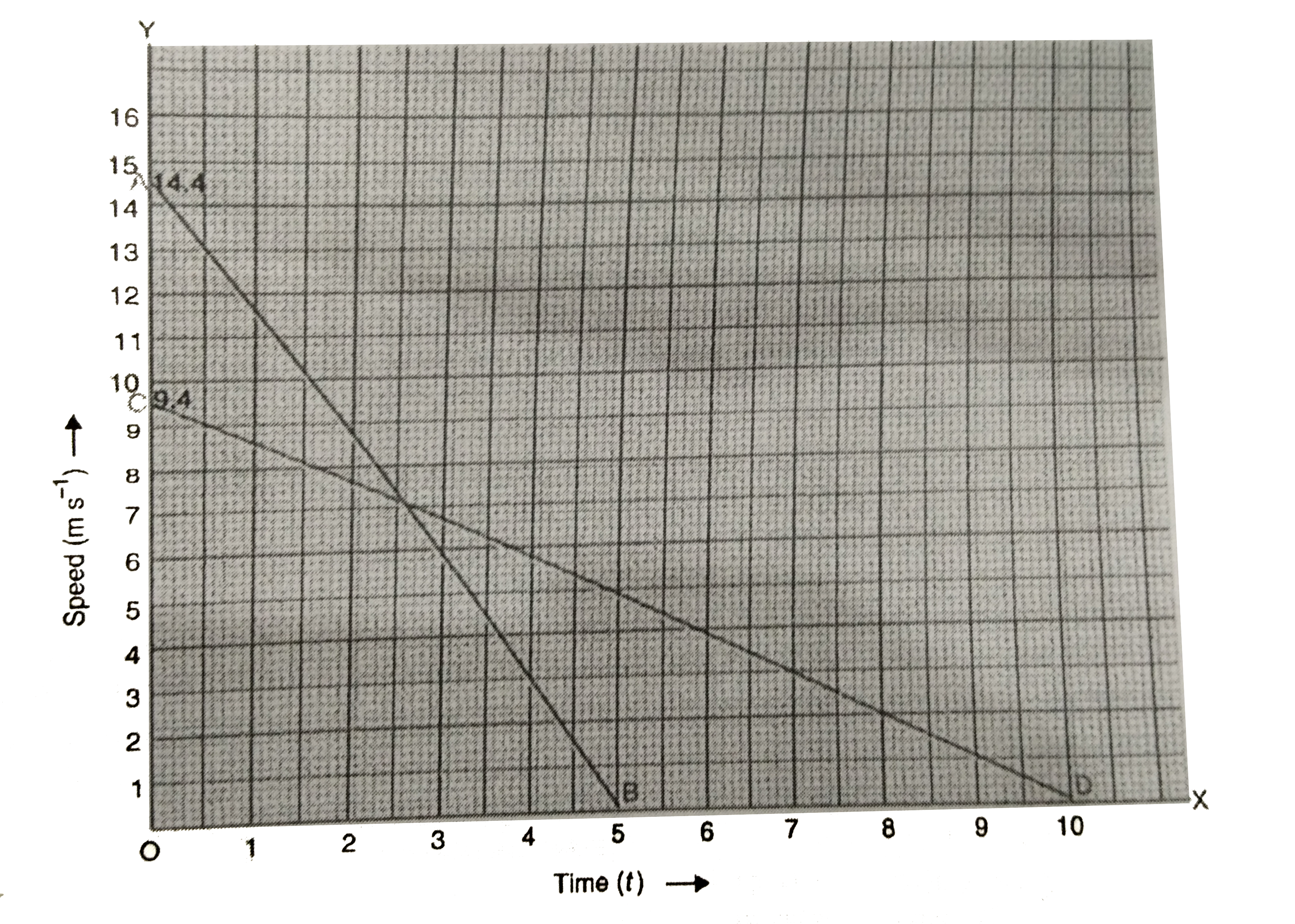A driver of a car A travelling at 54km/h applies the brakes and stops the car in 4 seconds. Another driver of car B travelling at 36km/h applies the brakes and stops the car in 6 seconds. Plot speed versus time graphs for the two car. which of the cars travelled farther before stopping ?
(a) For first car :
Initial speed, u = 52 km h−1
=52×1000 m60×60 s
=14.4 m s−1 …(1)
Final speed, v = 0 (The car stops) …(2)
And, Time take, t = 5 s ...(3)
(b) For second car :
Initial speed, u = 34 km h−1
=34×1000 m60×60 s
= 9.4 m s−1 ...(4)
Final speed, v = 0 (The car stops) ...(5)
And, Time taken, t = 10 s ...(6)
In order to plot the graph, we take time values on the X-axis and speed values on the Y-axis. Now, the

initial speed of first car is 14.4 m s−1 so, we take point A on the speed axis to represent a speed of 14.4 m s−1. The first car stops in 5 seconds, so we take point B on the time axis to represent the time of 5 s. Let us join the points A and B. The sloping straight line AB is the speed-time graph for the first car. Now, the initial speed of second car is 9.4 m s−1, so we take a point C on the speed axis to represent a speed of 9.4 m s−1. The second car stops in 10 seconds, so we take a point D on time axis to represent the time of 10 s. Let us join the points C and D. The sloping straight line CD is the speed-time graph for second car. Now :
(i) Distance travelled = Area under the graph line AB
by first car = Area of triangle OAB
=12×base×height
=12×5×14.4 m
= 36 m ...(7)
(ii) Distance travelled = Area under the graph line CD
by second car = Area of triangle OCD
=12×base×height
=12×10×9.4 m
= 47 m ...(8)
From the above calculations we find that the first car travels a distance of 36 metres before coming to a stop whereas the second car travels a distance of 47 metres before coming to a stop. Thus, the second car travelled farther after the brakes were applied.
Topper's Solved these Questions
- BOOK - LAKHMIR SINGH & MANJIT KAURCHAPTER - MOTION EXERCISE - SAMPLE PROBLEM1videos
MOTION
- BOOK - LAKHMIR SINGH & MANJIT KAURCHAPTER - MOTION EXERCISE - VERY SHORT ANSWER TYPE QUESTIONS3videos
MOTION
- BOOK - LAKHMIR SINGH & MANJIT KAURCHAPTER - MODEL TEST PAPER 5EXERCISE - Section B2videos
MODEL TEST PAPER 5
- BOOK - LAKHMIR SINGH & MANJIT KAURCHAPTER - SOUNDEXERCISE - Value Based Questions20videos
SOUND
Similar Questions
a driver of a car travelling at 52km/h applies the brakes and acceleration uniformly in the opposite direction. The car stops in 5s. Another driver going at 34km/h in another car applies his brakes slowly and stops in 10s. On the same graph paper, plot the speed versus time graphs for the two cars. Which of the two cars travelled farther after the brakes were applied ?
View SolutionA car travelling at 36km/h speeds upto 72km/h in 5 seconds. What is its acceleration ? If the same car stops in 20 seconds , what is the acceleration?
View Solution
Knowledge Check
- Question 1 - Select One
When the driver of a fast moving car suddenly applies brakes, the passengers in the car
Afall backwardBfall forwardCare not affectedDnone of these - Question 2 - Select One
When a car driver travelling at a speed of 10 m/s applies brakes and brings the car to rest in 20 s, then retardation will be :
A+2m/s2B−2m/s2C−0.5m/s2D+0.5m/s2 - Question 3 - Select One
A car is travelling with a speed of 36 km/hr.The driver applies the brakes & retard the car uniformly.The car is stopped in 5 seconds. The retardation of the car
A2 m/s^2B3ms2C4ms2D6ms2
A car travelling at 20 km/h speeds up to 6 km/h in 6 seconds. What is its acceleration ?
View SolutionA car is travelling 60 km in 2 h, then the distance travelled by the car in 6 h, if the speed remains constant, is :
View SolutionA car 2 m long travelling at 30ms−1 overtakes another car 4 m long travelling at 20ms−1. The time taken by the first car to pass the second car is
View SolutionA car is initially travelling at 50.0 km/h. The brakes are applied and the car stops over a distance of 35 m. What was magnitude of the car's acceleration while it was braking ?
View SolutionThe distance travelled by a motor car in t seconds after the brakes are applied is s feet where s=22t−12t2. The distance travelled by the car before it stops, is
View Solution

